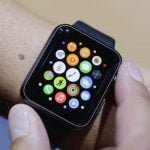

An attendee wears a virtual reality (VR) headset outside the Daimler AG exhibition stand ahead of the IAA Frankfurt Motor Show in Frankfurt, Germany, on Monday, Sept. 11, 2017. Photographer: Simon Dawson/Bloomberg
Technology continues to play a critical role in the evolution of society, including the upheaval of consumer-facing industries. For example, artificial intelligence opened the door to merchants and brands creating more personalized experiences to better meet the needs of today’s consumers. Virtual and augmented realities offered a new lens through which to view the world, creating new brand experiences. 3D printing provided the potential to individually manufacture products tailored to a consumer’s specifications.
While each of these technologies is disruptive in its own right, the internet has been one of the most transformative innovations of the modern era. In fact, connectivity is the new normal. As of 2017, almost half of the global population uses the internet with Euromonitor International projecting that three-fourths will have access by 2030. In particular, the smartphone and its on-the-go access introduced borderless internet, enabling consumers of all types to plug in no matter who they are or where they were.
The constant innovation driven by technology has generated and inspired a number of megatrends, or macroeconomic or geostrategic shifts, that are reshaping the world. Out of the eight megatrends identified by Euromonitor International, these five are the most influenced by technology:
(1) Connected Consumers
Connected Consumers use a variety of devices and interfaces to connect to the internet. While computers first brought internet into the home, mobile, in particular, ushered in a borderless internet, giving more consumers instant access to anything from anywhere. This digital connectivity, which underpins the very existence of connected consumers, has altered all aspects of life. Consumers leverage this connectivity for purposes like entertainment, education, knowledge, social sharing and shopping. This connectivity has disrupted – and arguably improved upon – many structures for doing such things. It has led to new value creations, giving consumers increased levels of convenience, simplicity and knowledge. It has redistributed power, providing consumers with a megaphone in the business transaction. It has altered the competitive landscape, disrupted long-standing industries and ushered in new business models. For businesses, staying relevant has never been harder, given the rapid pace of innovation driven by this widespread connectivity and related technologies.
(2) Shopping Reinvented
Economic and technological shifts have rewritten the shopping journey. In prior years, purchases revolved around the transaction itself with potentially a bit of word-of-mouth “research.” Today, shopping is a journey, whose purpose is not just about buying, but also relationship building. This shift has elevated the importance of the entire journey with each step serving as an opportunity to strengthen the brand and inspiring consumers to purchase more. Technology is woven into almost every aspect of “Shopping Reinvented” with the smartphone, in particular, keeping the shopper tethered from yesterday’s transaction to tomorrow’s relationship. In fact, the smartphone may be the most disruptive force yet unleashed on the once linear path to purchase with its always-on availability, transforming predictable consumer journeys into dizzying twists and turns. Other technologies like artificial intelligence, augmented and virtual realities and item-level sensors also are reinventing the way global consumers shop.
(3) Experience More
Consumers are increasingly spending more on experiences over things. Neuroscience from Cornell University supports that experiences – good or bad – make humans happier over the longer term than material possessions. Technology acts as an enabler of the “Experience More” megatrend by enhancing the overall experience, whether through big data capture to improve targeting, tailored choices or by technology being overlaid with reality to augment the experience. Technology plays an ever-greater role in helping consumers navigate mass choice to find the optimum brand experience. After the experience, consumers leverage technology to share stories and images online with friends and family.
(4) Premiumization
Premiumization is the megatrend about priorities. With more products available at more price points than ever before, consumers can spend more on the things that matter to them, while cutting back — often significantly — on those that do not. From DIY formats to made-to-order to smart diagnostics, digital technology plays a crucial role in accelerating demand for personalization. Whilst technology is giving consumers more options than ever, it is also creating more pressure to optimize those choices. Digital tools equip users with knowledge of the wider possibilities to address their needs and desires. In addition to driving demand for premium products, technology is also creating new models for selling them. Social media creates pressure to be unique, whilst consumers look to technology as a means of guiding their choices. Consumers will pay a premium both for products that set them apart and services that do the work of finding, customizing and offering expert guidance on using those products.
(5) Healthy Living
Healthy lifestyle habits are becoming a more normal way of life, as concerns over obesity, food sensitivity and the number of people impacted by different types of disease continues to rise. Technology is at the forefront of this behavioral shift, with devices, digital platforms and science evolution facilitating health tracking, diagnosis, general health awareness and personalized prevention concepts, which support the newly forming self-care model and approach by consumers today. Technology propagates a virtuous circle of healthy living. Advancements in research technology are constantly identifying and curing threats to human health and offering the possibility of living longer, more prosperous lives. Technology is also helping educate and empower consumers to take control, as well as providing personalized digital solutions for health tracking and self-care. Increased digital activation will accelerate the behavioral transformation toward preventative health.
Leverage the power of megatrends to shape strategy
Today’s environment of fast-paced change makes it more challenging than ever to keep up with competitors. Megatrend analysis helps businesses map and understand the changes occurring now and predict those occurring in the future. This type of analysis allows companies to build a long-term strategy that is proactive, rather than reactive, making sense of where they stand today, but also ensuring they have a plan to remain relevant moving forward.
[“Source-forbes”]




